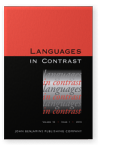Why suave movimiento isn’t ‘smooth movement’
A corpus comparison of polysemous adjectives in English and Spanish
Spanish suave is sometimes translated as English smooth or soft. In cluster analyses of data from the British National Corpus and the Corpus del Español, senses of suave are found to align in some ways with smooth, in other respects with soft, and sometimes with neither adjective. For instance, the ‘quiet’ sense of soft in soft noise is related to the ‘gentle’ sense in soft caress. The ‘quiet’ sense of suave is similarly related to a ‘gentle’ sense. On the other hand, both smooth election and suave transición ‘suave transition’ indicate an easy process, but smooth in smooth election clusters with the sense in smooth motion, whereas suave in suave transición clusters with the sense in suave velo ‘suave veil’. That is, a smooth election is ‘easy’ in the manner of an unobstructed motion, whereas a suave transición is ‘easy’ to deal with, like a lightweight burden.
References
Davies, M
2002-
Corpus del Español: 100 million words, 1200s-1900s. Available at
[URL] [last accessed 23 March 2015].

Davies, M
2004-
BYU-BNC. (Based on the British National Corpus from Oxford University Press). Available at
[URL] [last accessed 23 March 2015].

Divjak, D
2006 Ways of Intending: Delineating and Structuring Near Synonyms. In
Corpora in Cognitive Linguistics: Corpus-Based Approaches to Syntax and Lexis,
S.T. Gries and
A. Stefanowitsch (eds), 19–56. Berlin/New York: Mouton de Gruyter.

Divjak, D
2010 Structuring the Lexicon: a Clustered Model for Near-Synonymy. Berlin/New York: Mouton de Gruyter.


Divjak D. and Gries, S.T
2006 Ways of Trying in Russian: Clustering Behavioral Profiles.
Corpus Linguistics and Linguistic Theory, 2(1):23–60.


Evans, V
2005 The Meaning of Time: Polysemy, the Lexicon and Conceptual Structure.
Journal of Linguistics, 41(1):33–75.


Gries, S.T
2008 BehavioralProfiles 1.0. A program for R 2.7.1 and higher.
Gries, S.T. and Divjak, D
Gries, S.T. and Otani, N
2010 Behavioral Profiles: a Corpus-based Perspective on Synonymy and Antonymy.
ICAME Journal, 341:121–150.

Jenset, G.B. and Hareide, L
2013 A multidimensional approach to aligned sentences in translated text.
Bergen Language and Linguistics Studies, 3(1):195–210.


Leoni, F.A
2000-
SIMPLE-CLIPS ONTOLOGY. Available at
[URL] [last accessed 23 March 2015].

Sullivan, K. and Valenzuela, J
Forthcoming.
Contrasting word sense distinctions using bilingual comparable corpora: A pilot study of adjectives in English and Spanish. In
Usage-based approaches to Language Acquisition and Language Teaching,
Evers-Vermeul, J.,
Rasier L. and
Tribushinina, E (eds) Berlin Mouton de Gruyter
Suzuki, R., and Shimodaira, H
2014
pvclust: Hierarchical Clustering with P-values via Multiscale Bootstrap Resampling
. Available at
[URL] [last accessed 23 March 2015].
Tyler, A. and Evans, V
2001 Reconsidering Prepositional Polysemy Networks: the Case of over
.
Language, 77(4):724–765.


Cited by
Cited by 1 other publications
Egan, Thomas & Hildegunn Dirdal
This list is based on CrossRef data as of 4 june 2024. Please note that it may not be complete. Sources presented here have been supplied by the respective publishers.
Any errors therein should be reported to them.
